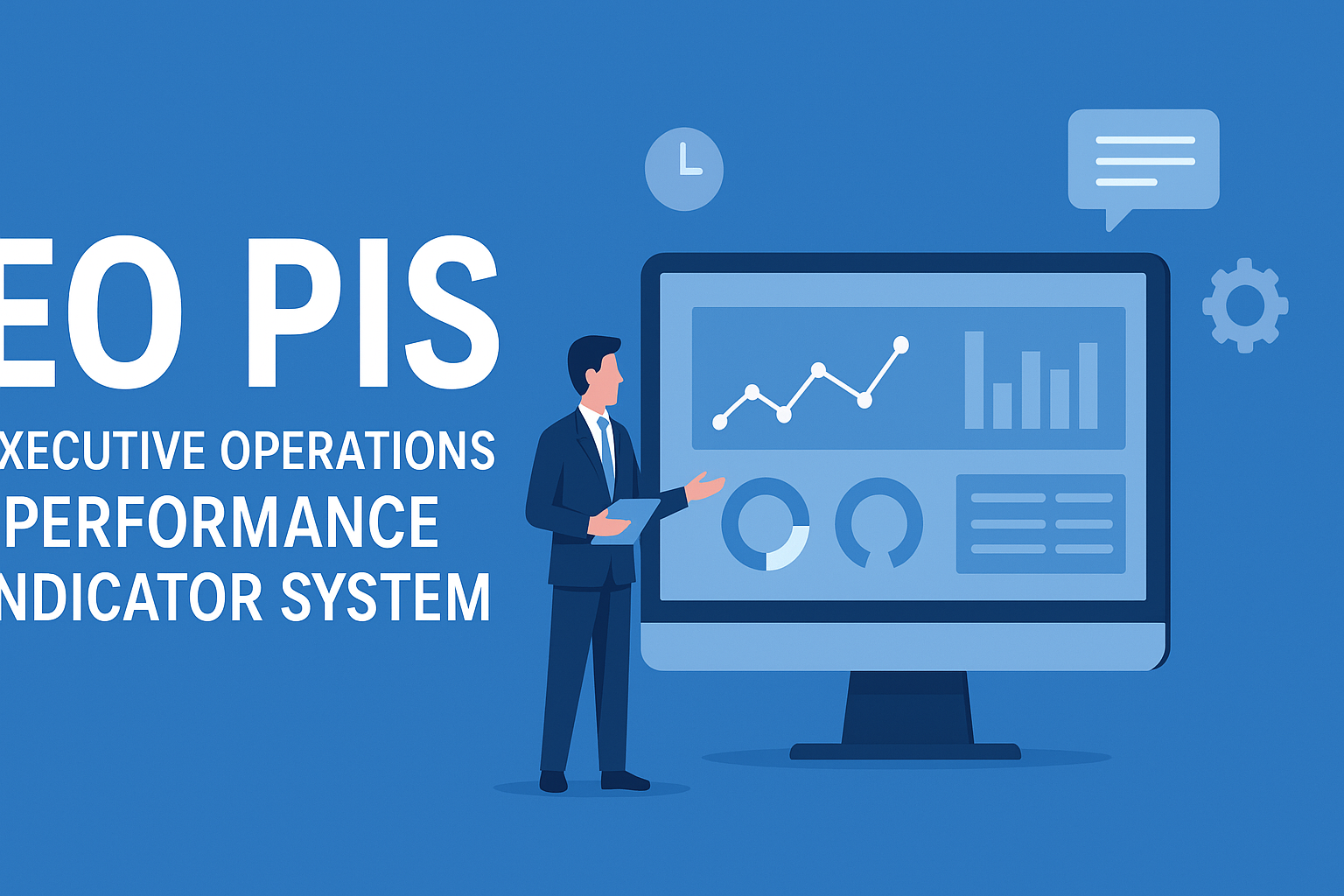
A 2022. Évi Téli Paralimpia Megnyitó Ceremóniája – A Grand Opening Beyond Sports
October 26, 2025
Candizi – Where Wellness Meets Delicious Simplicity
October 26, 2025Learn everything about EO PIS — the Executive Operations Performance Indicator System — its meaning, components, benefits, implementation process, and future role in executive decision-making.
also read: https://coomersparty.com/a-2022-evi-teli-paralimpia-megnyito-ceremoniaja/
Introduction
In today’s complex business world, executives need more than ordinary performance reports. They need real-time insights that connect operational activities to strategic outcomes. EO PIS, short for Executive Operations Performance Indicator System, serves this exact purpose.
EO PIS is a structured performance framework that helps top executives monitor, analyze, and optimize the overall performance of an organization. It transforms raw operational data into actionable executive intelligence, helping leaders make faster and more confident decisions.
In simple terms, EO PIS acts as a bridge between strategy and execution, ensuring that every department’s performance contributes to the organization’s long-term vision.
What Is EO PIS?
EO PIS stands for Executive Operations Performance Indicator System. It’s a comprehensive management tool designed to integrate performance metrics across departments and provide a unified view for executives.
While traditional KPIs focus on individual departments, EO PIS consolidates all performance data into one coherent system. It measures how well the entire organization functions in achieving strategic goals — not just operational targets.
Think of EO PIS as a digital control center where executives can track progress, predict outcomes, and identify risks before they turn into problems.
Why EO PIS Is Important for Executives
The modern business environment moves fast. Market conditions shift, technologies evolve, and customer expectations grow daily. Relying on static monthly reports simply doesn’t work anymore.
EO PIS provides real-time situational awareness. It tells executives what’s happening across departments — finance, production, marketing, HR, and customer service — all in one place.
Key reasons why EO PIS matters include:
- Unified Decision-Making: It prevents data silos and allows leaders to make coordinated decisions.
- Strategic Alignment: It connects everyday operations with long-term business goals.
- Speed and Accuracy: Real-time insights help leaders act faster and more precisely.
- Transparency: Everyone knows how their performance impacts company success.
In short, EO PIS empowers leadership to see the big picture and make data-driven decisions with confidence.
Core Components of EO PIS
An effective EO PIS is built on several critical components that work together to deliver accurate insights.
1. Centralized Dashboard
This is the heart of EO PIS — a unified interface displaying key metrics across departments. Dashboards show performance indicators in visual form, such as charts, graphs, and trend lines.
Executives can track essential metrics like sales growth, production efficiency, and cost performance at a glance.
2. Data Integration System
EO PIS gathers data from various tools — ERP systems, CRM software, HR databases, and supply chain platforms — and merges them into a single system. Integration ensures that all departments report to the same source of truth.
3. Strategic KPI Framework
KPIs in EO PIS aren’t random metrics. They are carefully chosen indicators aligned with the organization’s strategic goals. For example, if a company aims to improve customer satisfaction, its EO PIS might include metrics such as customer retention rate and service response time.
4. Predictive Analytics
Advanced EO PIS solutions use predictive analytics to forecast outcomes. Instead of only showing what happened, they also predict what might happen — allowing leaders to act proactively.
5. Reporting and Alerts
Automated alerts notify executives when performance deviates from targets. Reports can be generated weekly, monthly, or in real-time, ensuring continuous monitoring.
How EO PIS Works (Step-by-Step)
Below is a simplified view of how an EO PIS functions inside an organization:
| Step | Process | Description |
|---|---|---|
| 1 | Goal Setting | Define strategic and operational objectives for the company. |
| 2 | KPI Selection | Choose performance indicators aligned with these goals. |
| 3 | Data Collection | Integrate data from internal and external systems. |
| 4 | Data Analysis | Analyze trends, identify gaps, and generate insights. |
| 5 | Executive Reporting | Display results on dashboards for leadership review. |
| 6 | Continuous Improvement | Use insights to adjust strategies and drive improvement. |
This continuous loop ensures that decision-making remains data-driven and adaptive.
Key Benefits of EO PIS
Implementing EO PIS offers significant strategic and operational advantages:
1. Enhanced Decision-Making
Executives gain the ability to make fast, evidence-based decisions without relying on outdated reports.
2. Real-Time Visibility
With live dashboards, leaders can see performance trends instantly — from financial results to employee productivity.
3. Better Strategic Alignment
EO PIS links daily activities with long-term business goals, ensuring that every effort contributes to the company vision.
4. Higher Accountability
Because every department’s metrics are transparent, accountability improves at all levels.
5. Cost and Time Efficiency
Automated data collection and reporting reduce manual errors, saving valuable executive time.
6. Predictive Insight
Instead of reacting to issues, executives can predict them early — turning risks into opportunities.
EO PIS vs Traditional KPI Systems
| Aspect | Traditional KPIs | EO PIS |
|---|---|---|
| Focus | Department-specific metrics | Enterprise-wide alignment |
| Reporting Frequency | Monthly or quarterly | Real-time or continuous |
| Insight Level | Descriptive (what happened) | Predictive (what’s coming) |
| Users | Mid-level managers | Executives and C-suite |
| Integration | Limited data sources | Multiple, cross-functional sources |
| Goal | Monitor performance | Drive strategy execution |
EO PIS goes beyond traditional KPI frameworks by connecting every performance metric to the bigger picture.
Challenges in Implementing EO PIS
Like any large-scale system, EO PIS implementation can face obstacles:
- Data Quality Issues – Inconsistent or missing data can reduce accuracy.
- Integration Complexity – Merging multiple data systems takes time and planning.
- Resistance to Change – Employees may fear increased monitoring.
- Cost of Setup – Advanced EO PIS tools can require investment.
- Maintenance Needs – Continuous updates and governance are necessary.
These challenges can be overcome with clear communication, phased implementation, and leadership commitment.
Best Practices for a Successful EO PIS
To ensure your EO PIS delivers results:
- Start Small: Launch a pilot program focusing on one or two departments.
- Choose Meaningful KPIs: Avoid data overload — select only indicators tied to core strategy.
- Keep Dashboards Simple: Clear visuals make interpretation easier.
- Ensure Data Governance: Regular audits maintain accuracy and trust.
- Provide Training: Executives and teams must know how to use insights effectively.
Following these practices ensures EO PIS becomes a performance enabler rather than a reporting burden.
Future of EO PIS
As technology evolves, EO PIS will become smarter, faster, and more predictive. Future developments include:
- AI-Driven Insights: Artificial intelligence will detect patterns and suggest corrective actions automatically.
- Voice-Enabled Analytics: Executives will soon query EO PIS via voice assistants.
- Cloud-Based Platforms: Cloud storage will make global data access seamless and secure.
- Sustainability Metrics: Future EO PIS models will track environmental and social impact alongside financial metrics.
EO PIS is not just a reporting tool — it’s becoming a strategic intelligence system that shapes the future of executive management.
Frequently Asked Questions
1. What does EO PIS stand for?
EO PIS means Executive Operations Performance Indicator System — a framework for measuring and improving organizational performance.
2. Is EO PIS only for large corporations?
No, even small and medium businesses can implement EO PIS to align operations with strategy.
3. How is EO PIS different from KPIs?
KPIs are individual metrics; EO PIS is a holistic system connecting all metrics to executive goals.
4. Can EO PIS integrate with existing business tools?
Yes, it can pull data from ERP, CRM, HR, and financial systems into one dashboard.
5. How often should EO PIS reports be updated?
Ideally, data should update in real-time or at least daily for timely decision-making.
6. Does EO PIS require technical expertise to operate?
Modern EO PIS software is user-friendly and designed for executives, not just analysts.
7. What industries use EO PIS?
It’s widely used in manufacturing, finance, healthcare, retail, technology, and logistics.
8. Can EO PIS improve employee engagement?
Yes, transparency and alignment motivate employees by showing how their work impacts company goals.
9. How long does EO PIS implementation take?
Typically, 3–6 months depending on the size and complexity of the organization.
10. Is EO PIS a one-time setup or ongoing process?
It’s continuous — EO PIS evolves with business goals and market changes.
Conclusion
The Executive Operations Performance Indicator System (EO PIS) is revolutionizing how companies manage performance. By integrating data, aligning operations with strategy, and offering predictive insights, EO PIS empowers executives to lead with clarity and confidence.
Instead of relying on scattered departmental reports, EO PIS provides a single version of truth for the entire organization. With proper implementation, it enhances decision-making, accountability, and business agility — exactly what modern leadership demands.
In essence, EO PIS is not just a dashboard — it’s a strategic compass guiding your organization toward consistent, measurable success.




